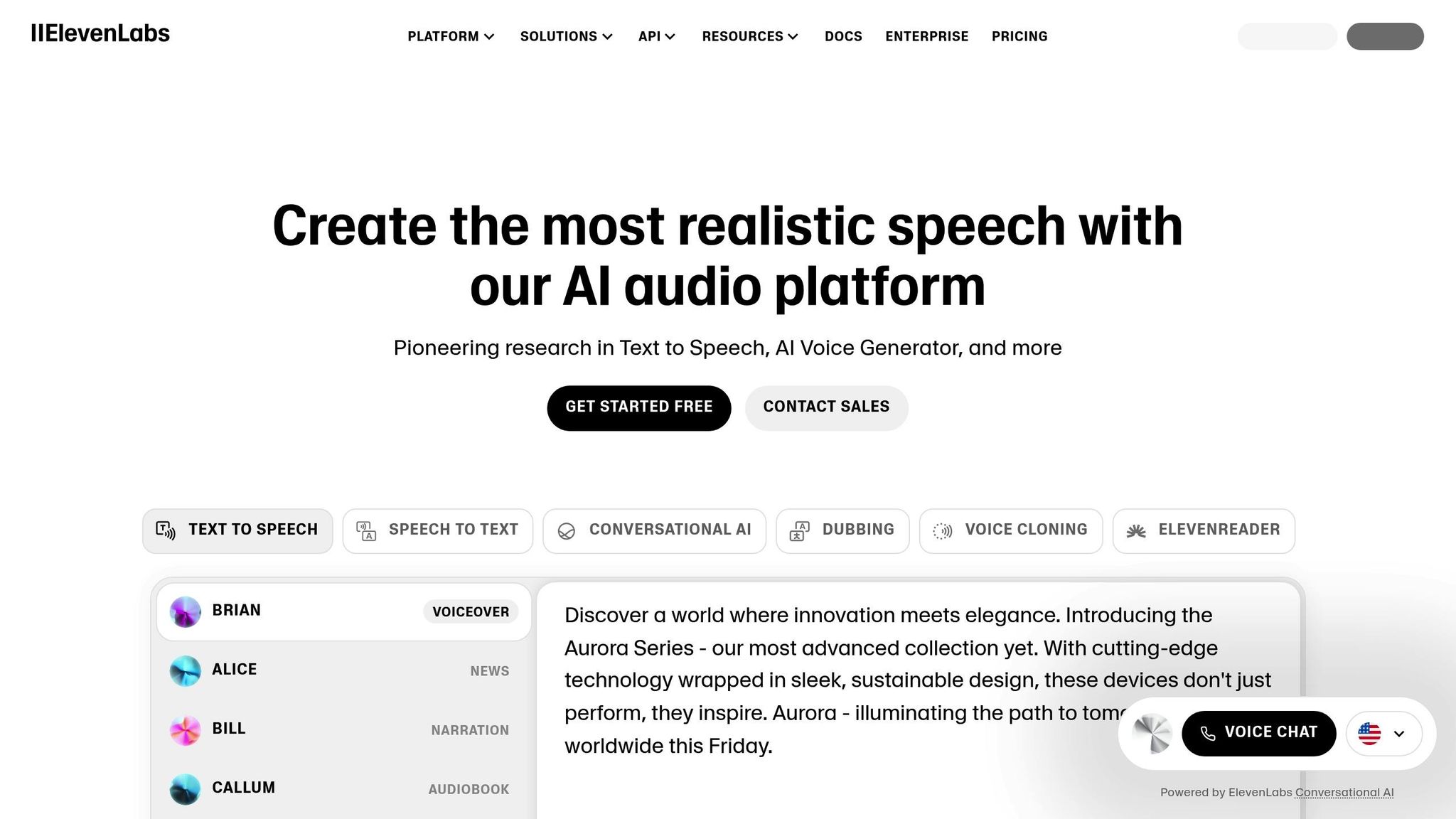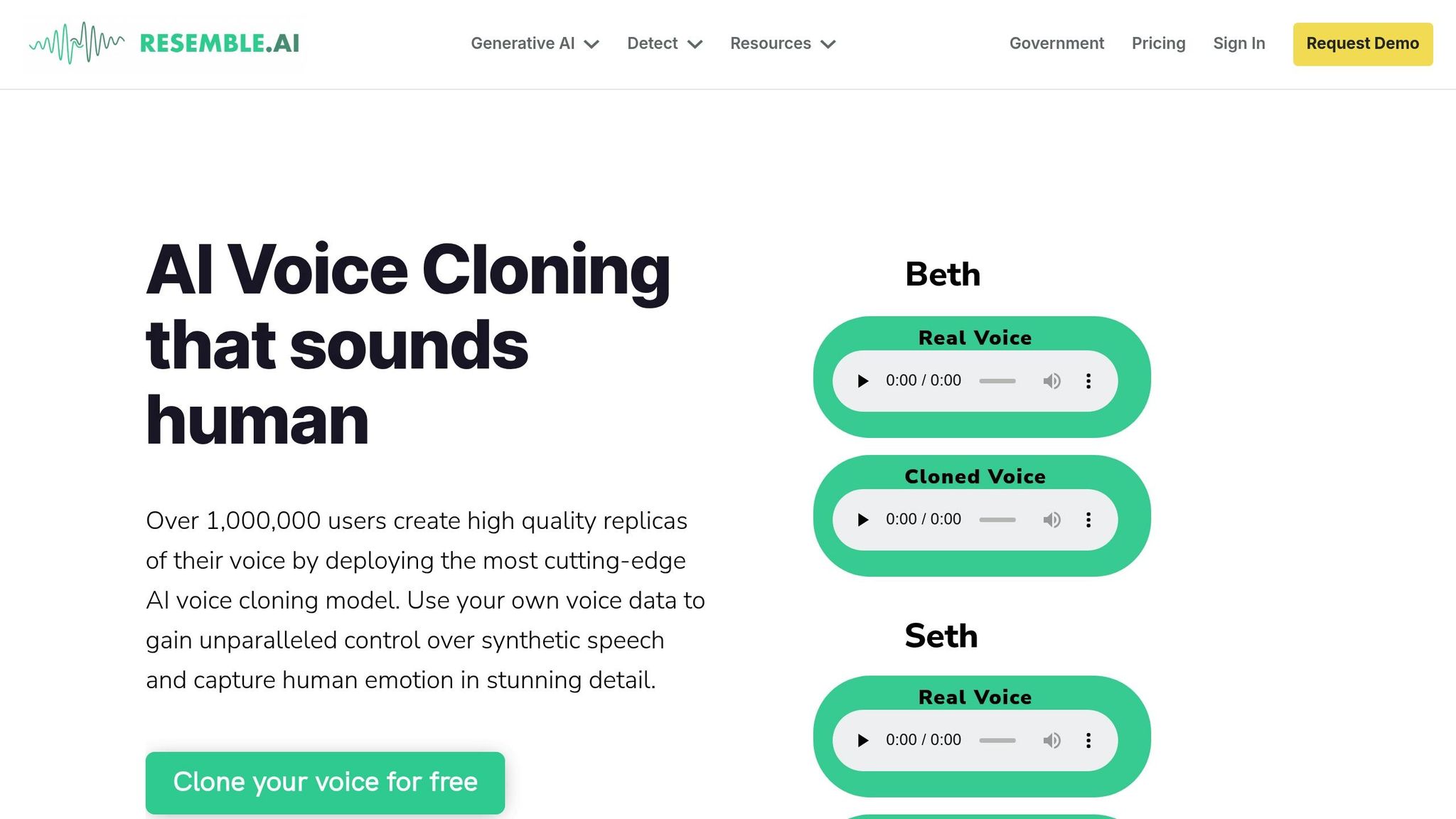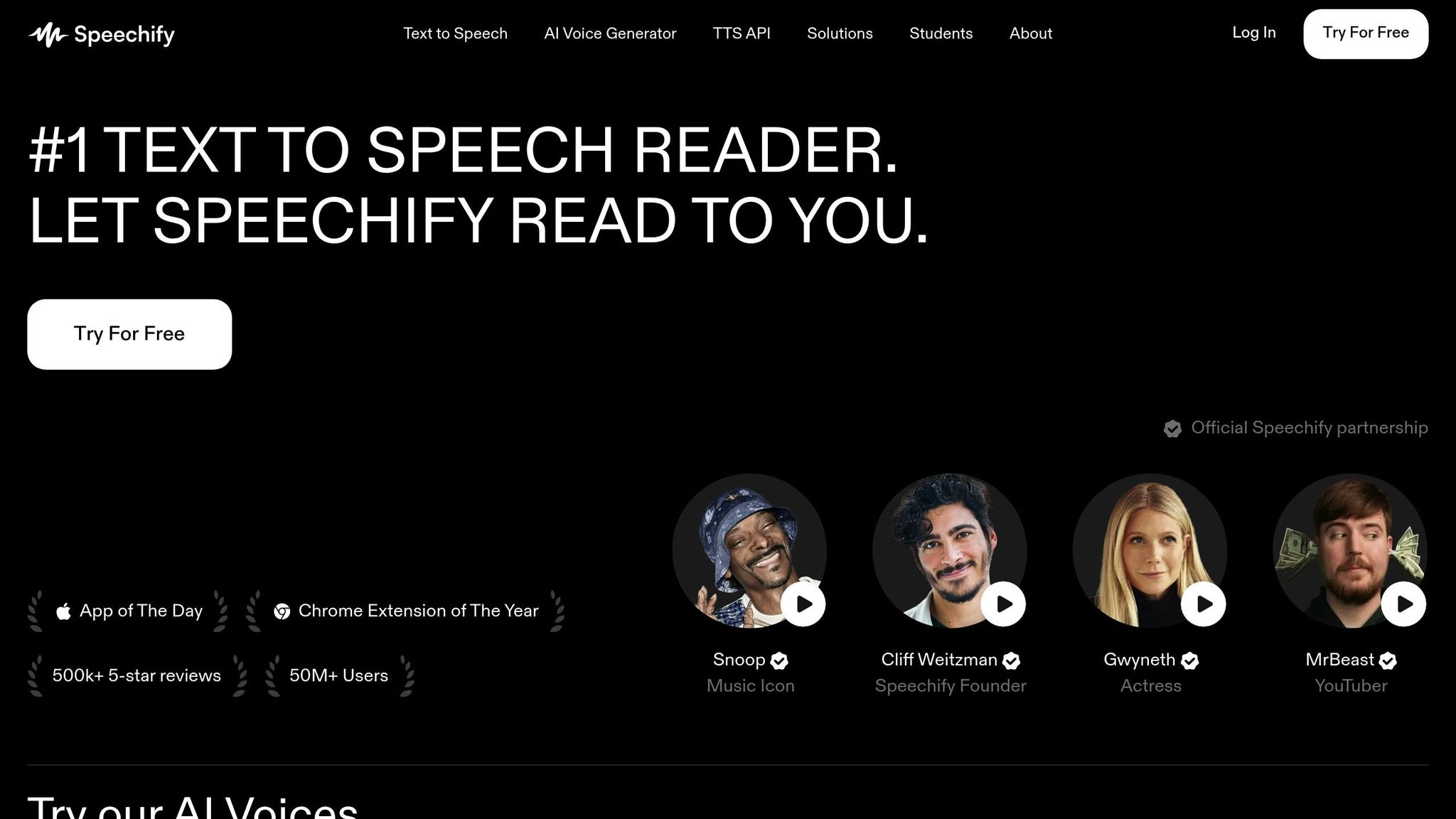Voice cloning is now simple, fast, and affordable. With just 30 seconds of audio, tools like ElevenLabs, Resemble AI, and Speechify can create a digital replica of your voice. These tools are used for audiobook narration, personalized assistants, and even accessibility solutions for speech impairments. Here's a quick breakdown:
- ElevenLabs: High-quality voice output with advanced customization, starting at $11/month.
- Resemble AI: Emotional voice cloning with just 10 seconds of audio, priced at $25/month.
- Speechify: Browser-based, supports 60+ languages, with a free tier available.
Quick Comparison
| Feature | ElevenLabs | Resemble AI | Speechify |
|---|---|---|---|
| Audio Sample Needed | 30 minutes | 10 seconds | Standard samples |
| Customization | Advanced | Emotion-focused | Basic |
| Languages Supported | 29+ | Multiple | 60+ |
| Free Tier | Yes (10k chars) | Contact sales | Limited features |
| Starting Price | $11/month | $25/month | Free/Varies |
Voice cloning is transforming industries, but ethical use and security are critical. Always get consent before cloning a voice and use safeguards to prevent misuse. Dive into the full article to learn more about how this tech works and its potential applications.
AI Voice Cloning Tutorial: How To Clone Your Own Voice
Voice Cloning Basics
Voice cloning technology leverages advanced AI to transform your recorded speech into a precise digital replica. Let’s break down the essentials of what’s needed for this process and how AI makes it happen.
Voice Sample Requirements
To achieve high-quality voice cloning, the initial recordings play a critical role. Here’s what you’ll need:
- At least 30 minutes of clear audio for basic results.
- 2–3 hours of recordings for professional-grade accuracy.
- Audio that’s free from background noise or interruptions.
- Consistent speaking style throughout all samples.
For the best results, record in a controlled environment using professional equipment:
- A high-quality microphone to capture sound accurately.
- A pop filter to reduce harsh consonant sounds.
- An acoustically treated room to minimize echo.
- A single, clear speaking voice free of overlapping sounds.
With the right setup and preparation, your recordings will provide the foundation for an accurate digital voice replica.
How AI Learns Voice Patterns
Once the recordings are ready, AI steps in to analyze and replicate your unique vocal traits. Here’s how the process works:
- Voice Analysis and Feature Extraction The AI breaks down your recordings into phonemes - the smallest units of sound - and identifies key features like accent, rhythm, and tone. These details are then used to train the system for precise replication.
- Neural Network Training Using advanced machine learning, the AI trains a neural network on the extracted features. This enables the system to mimic your voice with impressive accuracy, capturing its unique essence.
"Voice cloning is the process of using artificial intelligence (AI) to generate a synthetic copy of a human's voice. At its core, it involves analyzing the sound patterns of a specific voice and then reproducing them so accurately that the cloned voice is nearly indistinguishable from the original." - ElevenLabs
The result? An AI model capable of generating speech that sounds just like you - even creating entirely new phrases that you never recorded.
3 Easy-to-Use Voice Cloning Tools
Let’s take a closer look at three voice cloning tools that stand out for their ease of use and unique features.
ElevenLabs: High-Quality Voice Creation

ElevenLabs is known for producing lifelike voice replicas, boasting 89.60% naturalness and 81.97% pronunciation accuracy.
Here’s what makes it stand out:
- Voice stability
- Similarity controls for fine-tuning
- Style exaggeration to add flair
- Multi-language support
The pricing is flexible, starting with a free plan that includes 10,000 characters per month and up to three custom voices. Paid plans scale from $5 to $330 per month, catering to different usage needs.
Resemble AI: Voice Cloning with Emotions

Resemble AI takes a unique approach by allowing users to create a basic voice clone with just 10 seconds of audio.
"Zomato partnered with Truefan and Resemble AI to deliver 354,000 customized greetings, achieving a 90% voice accuracy rate." - Zomato Implementation Report
One of its standout features is the speech-to-speech functionality, which lets users adjust emotional tones and speaking styles. By using their own voice as input, they can create highly personalized results.
Speechify: Simple Browser-Based Tool

Speechify offers a straightforward, browser-based experience with fast processing, an intuitive interface, and support for over 60 languages. While its response time is slightly slower than ElevenLabs’ benchmark of 135ms, it remains a reliable option.
The platform’s tiered pricing unlocks additional voice options and features, making it accessible for various needs.
| Feature Comparison | ElevenLabs | Resemble AI | Speechify |
|---|---|---|---|
| Minimum Sample Required | 30 minutes | 10 seconds | Standard samples |
| Processing Speed | 135ms | Variable | Slightly longer |
| Voice Customization | Advanced | Emotion-focused | Basic |
| Free Tier Available | Yes (10k chars/month) | Contact sales | Limited features |
This table highlights the strengths of each platform, offering a clear view of how they cater to different voice cloning needs. Whether you’re looking for advanced customization, emotional nuance, or simplicity, there’s a tool to match your goals.
sbb-itb-212c9ea
Common Uses for Voice Cloning
Voice cloning is transforming audio content creation, offering practical solutions for media production and personal communication alike.
Media Production Uses
In the entertainment world, voice cloning has become a game-changer. For example, game developers can create diverse character voices using a single voice actor, adding depth and variety to their games' storytelling.
Content creators are also tapping into this technology for tasks like:
- Audiobook narration: Producing high-quality, consistent narration for books.
- Video content narration: Adding professional voiceovers to videos.
- International dubbing and localization: Making content accessible to global audiences in their native languages.
But its usefulness doesn’t stop there. Voice cloning is also making a big impact in personal communication and improving accessibility.
Personal and Accessibility Uses
Voice cloning is opening new doors for personal communication and accessibility. Take, for instance, the groundbreaking work by SilenceSilence.ai in January 2024. They developed personalized voice replicas for patients with Broca's aphasia, enabling them to communicate more effectively.
"Every voice deserves to be heard, and every person deserves the opportunity to communicate with dignity and confidence. With SilenceSilence™ AI conversational voice cloning technology, we are not just restoring voices; we are restoring lives." - Dr. Kelli Uitenham
This technology allows individuals to preserve their voice for future use, create custom text-to-speech tools, and maintain their vocal identity. For professionals like teachers and broadcasters, it offers a way to safeguard their unique voice. Additionally, it supports individuals with conditions like dysarthria by generating synthetic speech that reflects their distinct speech patterns.
Voice cloning is proving to be more than just a technological advancement - it's becoming a tool for empowerment and accessibility.
Safety and Ethics Guidelines
With voice cloning becoming more common, it's crucial to establish clear ethical and safety measures to prevent misuse and safeguard individuals.
Getting Permission
California's Civil Code Section 3344 emphasizes the importance of voice rights, stating that using someone's voice without prior consent can lead to legal consequences.
"At the core of our ethical approach is a robust consent system that ensures voice cloning only occurs with the explicit consent of the individual".
Before cloning a voice, it’s essential to secure written consent, clearly outline the scope and duration of its use, and address any commercial rights. Along with obtaining consent, it’s equally important to implement strong security measures to protect the cloned voice from unauthorized use.
Security Best Practices
Once consent is in place, maintaining trust requires strict security protocols. A 2024 demonstration by NetSPI highlighted the risks of voice cloning when they used a cloned manager’s voice during a security test, successfully tricking an employee into revealing login credentials.
| Security Measure | Implementation Method | Purpose |
|---|---|---|
| Identity Verification | One-time passcodes or video ID verification | Prevent unauthorized access |
| Safe Word System | Unique verification phrases | Enable quick authentication |
| Watermarking | Platforms with built-in watermarking tech | Track content origins |
| AI Detection Tools | Tools like Resemble Detect | Identify synthetic voices |
"To meet the challenges voice cloners pose, organizations must implement robust verification processes and conduct employee training to better position their organization against modern threats." - Rafael Seferyan, NetSPI
For individual users, the following steps can help protect against misuse:
- Verify unusual requests: Be cautious of unexpected voice calls, especially those involving financial transactions.
- Leverage technology safeguards: Use AI detection tools to distinguish real voices from synthetic ones.
- Report suspicious activity: Notify the FTC or IC3 about any suspected misuse of voice cloning.
- Monitor usage: Regularly review how your cloned voice is being used to ensure compliance with agreed terms.
Voice cloning platforms strictly prohibit using synthetic voices for harmful purposes, such as hate speech, discrimination, libel, terrorism, violence, or the exploitation of children. Technologies like Resemble Watermark make it easier to trace the origins of voice-cloned content, ensuring accountability and preventing misuse.
Conclusion: Pick the Best Tool for You
Selecting the right voice cloning tool comes down to what fits your unique needs. User reviews and performance stats can help narrow down your choices.
If you're a professional content creator, ElevenLabs might be your best bet. It delivers high-quality voice output with plenty of customization options, starting at $11/month for its Creator plan.
For quick and simple voice cloning, Resemble AI stands out. It only needs 10 seconds of audio to get started, with its Professional Voice Clone service priced at $25/month for 100 minutes.
When deciding, keep these factors in mind:
| Factor | What to Look For | Why It Matters |
|---|---|---|
| Audio Sample Length | 10–30 seconds required | Shorter samples mean quicker setup. |
| Language Support | Number of supported languages | Ensures it works with your content needs. |
| Latency | Response time for voice generation | Essential for real-time applications. |
| Cost per Minute | Price for audio generation | Affects long-term affordability for projects. |
These guidelines help highlight each tool's strengths and how they align with your goals.
Most platforms offer tiered pricing plans, and many include free trials. Take advantage of these trials to test voice quality, ease of use, and speed before committing.
FAQs
What ethical guidelines and permissions should you follow before using AI to clone someone's voice?
Cloning someone's voice using AI demands their explicit consent, ensuring they are completely informed about how their voice will be utilized. This step is crucial to safeguard their rights and prevent any unauthorized use.
Equally important are the ethical considerations, like respecting the person's privacy and making sure their voice data isn't exploited. Transparency should always come first, and obtaining clear, documented permission is a must before starting any voice cloning endeavor.
How does the length of an audio sample impact the quality of an AI voice clone?
The length of the audio sample is a critical factor in determining the quality and precision of an AI-generated voice clone. Longer audio samples, ideally spanning 2–3 hours, give the AI more material to work with. This allows it to capture a broader range of vocal traits, such as tone, inflection, and subtle nuances, resulting in a more natural and accurate voice replication.
In contrast, shorter samples, especially those under 30 seconds, don’t provide enough data for the AI to fully understand the speaker's unique vocal characteristics. As a result, the generated voice may lack realism or fail to replicate the finer details of the original voice. To achieve the best outcomes, it's essential to provide clear, high-quality audio with as much length as possible.
How can you protect against unauthorized use of a cloned voice, and how reliable are these methods?
To safeguard against the misuse of a cloned voice, there are a few smart steps you can take. For starters, verify the identity of the person you're speaking with, especially in sensitive situations. Another layer of protection is setting up a unique safe word for private conversations. On the tech side, tools like voice authentication systems and deepfake detection software can add an extra shield of security. Many AI platforms also come equipped with features like moderation, voice verification, and classifiers that help flag AI-generated content.
While no approach guarantees complete protection, combining these strategies can make a big difference. Staying alert and relying on trusted tools with built-in safeguards can help keep your voice cloning efforts secure and responsibly managed.



